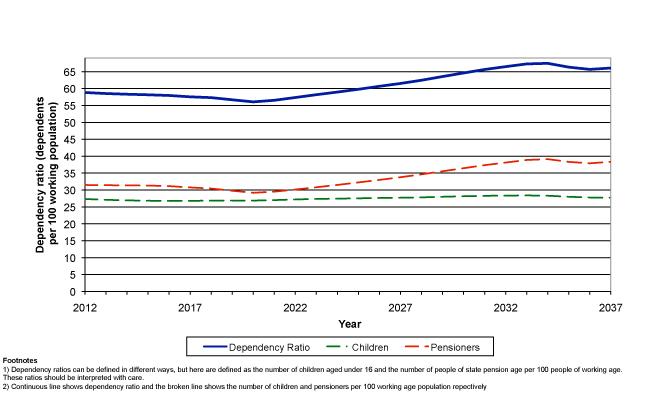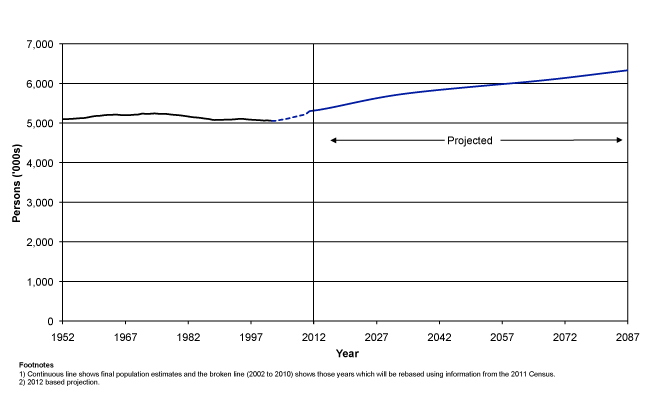
3.1. The results of this new set of projections, summarised in Table 1 and illustrated in Figure 1, show the total population of Scotland increasing from 5.31 million in 2012. After this, the population is projected to reach 5.52 million in 2022 (an increase of about 206,000 or 4 per cent compared with 2012) and then 5.78 million by 2037 (a 9 per cent increase on the 2012 level). Looking further ahead, the population is projected to continue to rise, reaching around 6.3 million by 2087.
Figure 1: Estimated population of Scotland, actual1 and projected2, 1952- 2087

3.2. Table 2 provides information on the projected components of change between 2012 and 2037. The table shows that up until around 2033 natural change and migration both act to increase the size of the population as the number of births exceeds the number of deaths and there are more people coming to Scotland than leaving. After that point, the number of deaths exceeds the number of births whilst net in-migration continues.
3.3. Over the next decade, 28 per cent of the projected increase in Scotland's population can be attributed to natural increase (more births than deaths) while 72 per cent of the increase is due to assuming continuing inward net migration to Scotland.
3.4. As Figure 2 shows, the number of births in Scotland fell significantly between the early 1960s and 2002, dropping below the number of deaths in 1995. Between 2002 and 2009, the number of births increased steadily but then it dipped (by around 900 births) to 58,500 in 2012. Since 2010 the level of natural increase (more births than deaths) has been decreasing, as the numbers of births has decreased and the number of deaths has increased. The projections suggest a slight increase in the number of births until a peak in 2023 of around 60,600. Thereafter births generally decline but only to about 58,200, remaining well above the historically low number of births observed in 2002 (51,300). Meanwhile, the number of deaths is projected to fall until 2016 reaching a low of around 52,700, before increasing back to the levels experienced in the 1990s by 2037. This results in a change from natural increase (more births than deaths) to natural decrease (more deaths than births) from 2033 onwards.
Figure 2: Births and deaths, actual1 and projected2, Scotland, 1952-2037
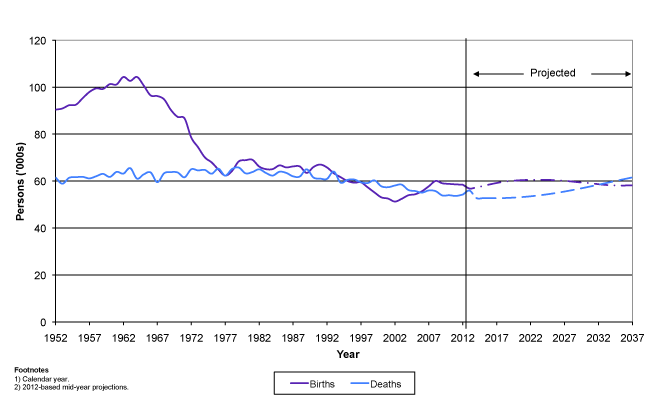
3.5. As Figure 3 shows, Scotland has historically been a country of net out-migration with more people leaving the country than coming in. However, since 2002-2003 Scotland has experienced net in-migration, and therefore these projections have assumed that Scotland will continue to experience a net inflow. The size of this net inflow is assumed to rise steadily to 15,500 by 2018-19, and staying at this level for the remainder of the projection period.
Figure 3: Estimated1 and projected2 net migration, Scotland, 1952-2037
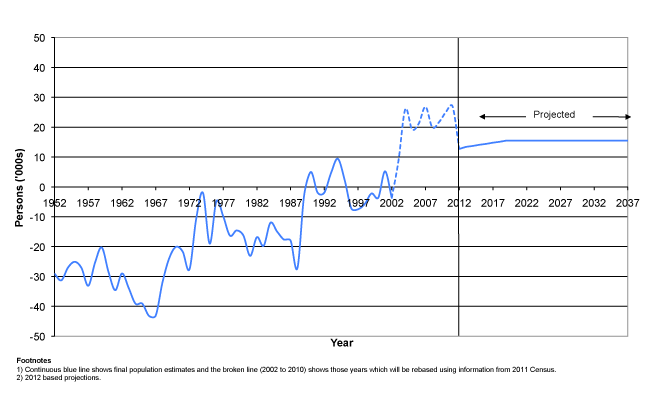
3.6. More detailed information on the fertility, mortality and migration assumptions leading to these results is given in Section 4 and Annex A, Annex B and Annex C.
3.7. A population pyramid is a good way of illustrating the age and sex structure of the population. Figure 4 represents the population of Scotland as estimated in mid-2012 and projected for mid-2037 and shows that Scotland's population is projected to age markedly. Each bar in the pyramid represents a single year of age and the length of the bar relates to the number of people of that age in the population. The size and composition of the population is determined by the pattern of births, deaths and migration which have taken place in previous years. The solid bars represent the estimated population for mid-2012 and the lines represent the projected population in mid-2037.
Figure 4: Estimated and projected age structure of Scotland's population, mid-2012 and mid-2037
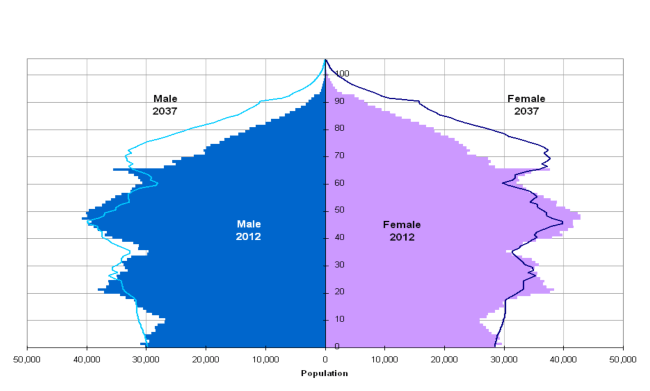
3.8. A summary of projected populations in broad age groups is given in Table 3, and projected populations by sex and five year age groups are given in Table 6. These tables and Figure 5 also show that the age structure of the population is projected to age noticeably between 2012 and 2037.
Figure 5: The projected percentage change in Scotland's population by age group, 2012-2037
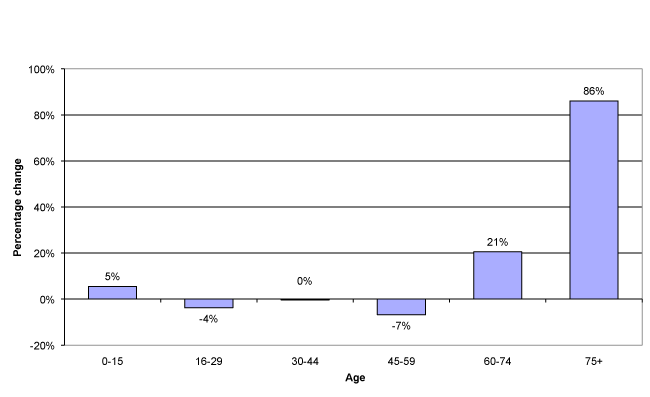
3.9. Scotland's population is projected to increase by 9 per cent between 2012 and 2037, however this increase is not spread evenly across all age groups of the population. As Figure 5 shows, the population aged under 60 is projected to remain fairly constant with a small decrease in the 45-59 age group and a small increase in the number of the 0-15 age group whilst the number of older people is projected to increase significantly especially the 75+ age group.
3.10. Between 2012 and 2037, the number of children (those aged 0-15) is projected to increase by 5 per cent from 0.91 to 0.96 million. Figure 6 shows that most of this increase is due to children in the 5-11 age group who are projected to increase from 383,000 in 2012 to 424,000 in 2037 (an increase of 11 per cent).
Figure 6: Estimated and projected numbers of children aged 0 to 15, Scotland, mid-2012, mid-2022 and mid-2037
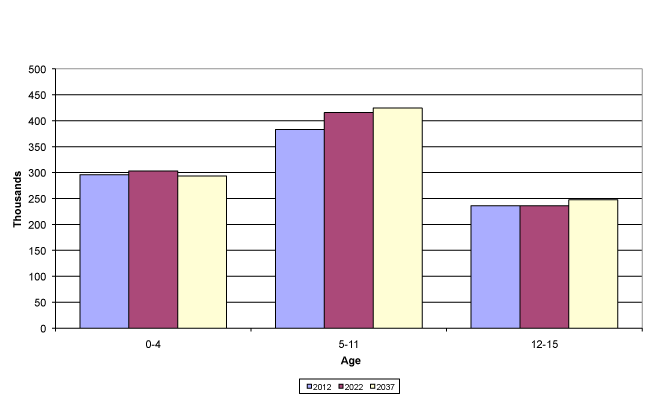
3.11. The number of people aged 75 and over is projected to increase by around 28 per cent from 0.42 million in 2012 to 0.53 million in 2022. It is then projected to continue rising, reaching 0.78 million in 2037 - an increase of 86 per cent over the 25 year period. This is because mortality rates are projected to improve, increasing the population at older ages.
3.12. Figure 7 shows that Scotland's population aged 70 and over is projected to rise considerably over the next 25 years. The number of people aged 80 and above is projected to more than double by 2037 (increase of about 105 per cent) and the number of centenarians (those aged 100 or more) is projected to rise from 800 to 7,800 by 2037, more than an eightfold increase.
Figure 7: Estimated and projected population aged 70 and over, Scotland, mid-2012, mid-2022 and mid-2037
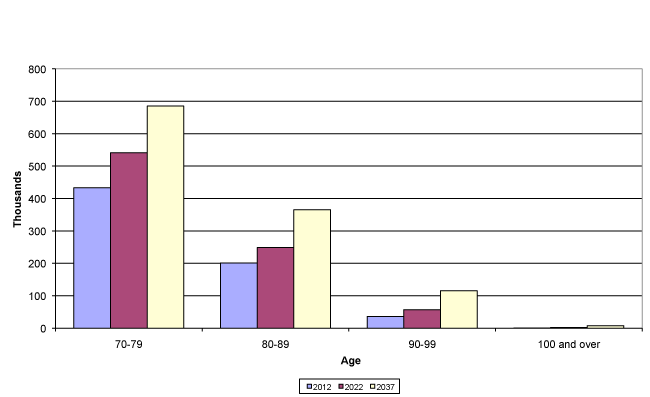
3.13. The figures for working age and pensionable age take into account the increases in the state pension age as set out in the 2011 Pensions Act. Between 2012 and 2018, the state pension age will change from 65 years for men and 61 years for women, to 65 years for both sexes. Then between 2019 and 2020, it will rise from 65 years to 66 years for both men and women. A further rise in state pension age will take place in two stages between 2034 and 2046 to bring the state pension age from 66 to 68 for both sexes. The data presented here do not reflect proposed further changes to the state pension age published by the UK government. They propose bringing forward the increase to State Pension age 67, to be phased in between 2026 and 2028. These proposed changes are not yet law and still require the approval of the UK Parliament. Further information regarding these changes can be found at: www.gov.uk/changes-state-pension.
3.14. The population of working age is projected to increase from 3.35 million in 2012 to 3.51 million in 2021 (an increase of 6 per cent). It is then projected to decrease to 3.43 by 2032, before rising to 3.48 million by 2037. This is a 4 per cent increase over the 25 year period.
3.15. The number of people of pensionable age is projected to be relatively constant over the next ten years, rising slightly from 1.05 million in 2012 to 1.06 million in 2022 (an increase of 0.4 per cent over the 10 year period). It is then projected to rise more rapidly, reaching 1.34 million in 2037 (an increase of around 27 per cent compared with 2012).There are some noticeable changes in the projected population for this age group over the 25 year period but these are mostly due to the changes in state pension age.
3.16. A useful summary measure of the age structure of a population is the dependency ratio which is shown in Figure 8 - the ratio of people aged under 16 and those over pensionable age, to those of working age. Dependency ratios can be defined in different ways, but here are defined as the number of children aged under 16 and the number of people of state pension age per 100 people of working age. These ratios should be interpreted with care. For example, a simple interpretation is the number of older people or children who are 'dependent' on the working age population, the assumption being that most older people and children are not economically active. The reality is of course much more complex, since - to give just a few reasons - many people of typically working age are unemployed or economically inactive (e.g. at school or university), the age at which people retire varies greatly and many retired people are financially independent. However, these 'dependency' ratios provide a useful way to examine the relative age structure of the population.
3.17. Table 4 shows that the dependency ratio is projected to decrease to around 56 per 100 by 2020. Between 2020 and 2024 the dependency ratio is projected increase to 59 per 100 working age population. It then starts rising steadily, reaching 66 per 100 by 2037.
3.18. In 2012, the 59 dependents per 100 working age population were made up relatively evenly of children (27 per 100) and pensioners (31 per 100). By 2037 the distribution is projected to have changed to 28 children and 38 pensioners per 100 population of working age. Therefore, the increase in dependency ratio can be mainly attributed to the increase in people of state pension age per 100 working age population over the 25 year period.
Figure 8: Dependency ratio1,2 (dependents per 100 working age population) Under the 2012-based principal projection, 2012-2037
